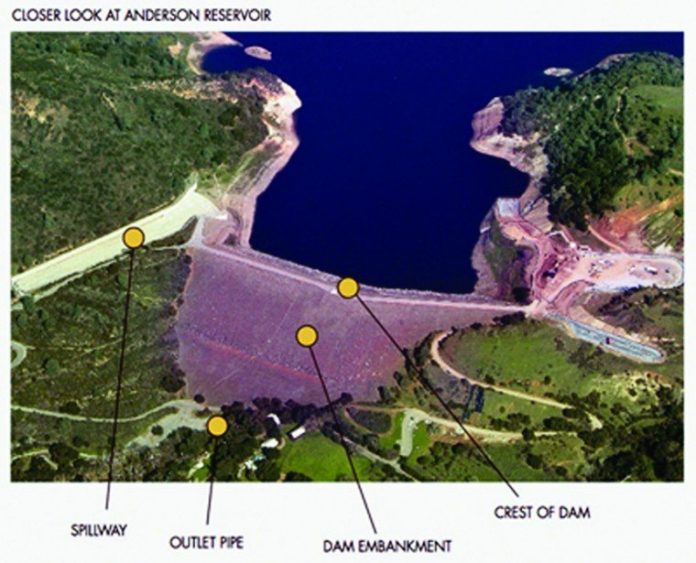Although still in the planning stages, the potential price tag for the Anderson Dam retrofit project was bumped up from $110 million to an estimated $185 million.
According to a seismic study completed in July 2011, Anderson Dam – which holds up to 90,373 acre-feet of water – was deemed unsafe, with the possibility that if a large earthquake (7.2 or greater) strikes within a 1.25 miles of the dam, a 35-foot wall of water would rush to Morgan Hill, putting it under water in roughly 15 minutes, flood Gilroy, San Martin and the entire valley floor up to San Jose within a couple of hours.
According to Santa Clara Valley Water District spokesperson Marty Grimes, the new Capital Improvement Project, still in its drafting stages and not-yet approved by the SCVWD board of directors, increases the estimate of the capital project for Anderson an additional $75 million from the original estimate of $110 million.
One factor for the increase, Grimes said, is outlet work not originally included in the estimate. Outlet work will be done where the water is released from the dam, he said. During a preliminary study four fault lines were found under the dam, said Hemang Desai, the acting senior engineer for the project.
“Whether they are inactive or active is part of the planning study as well,” he said.
The planning study report has a target completion date of February 2013. The three-year project, which Desai said is currently “on track,” is expected to begin construction at the end of 2015 and be complete by 2018. The planning study report will recommend the construction method, the feasible alternatives to fix the dam and spillway and determine a more real cost for the entire project. Although the price is currently set at $185 million, Grimes said it may fluctuate depending on what the planning study finds.
“It’s still in that ballpark. We still have to go through the planning stages. At the end of the planning study, we’ll have a better number,” said Grimes.
That number will depend on what materials are used to rebuild the dam and how complicated the project becomes.
So far, $2.8 million was spent on the seismic stability study for Anderson, with an additional $550,000 spent on the capitol project. More than $3.6 million was set aside for the recently approved contract with a project management consultant service.
Desai said drainage of the dam is not expected for the design and planning phases of the project.
“The only time we may drain the reservoir is during construction,” he said. “We wouldn’t know how long the duration would be, or how much.”
Even so, some water will remain in the debt pool, said Grimes. Although the amount is not yet determined if it will be enough for recreational activities.
In 2009, the California Division of Safety of Dams required the water district to keep Anderson Reservoir’s water level at 74 percent capacity, because the dam’s foundation contains sand and gravel that could liquefy in a big quake.
Since October 2010, the water storage restriction has been lowered to 57 percent capacity, with a maximum capacity of up to 68 percent. Currently, the water is at 48 percent, said Desai.
In October 2009, the publicly funded wholesale water provider to most of Santa Clara County, received preliminary findings from an ongoing seismic stability evaluation for Anderson Dam that detailed part of the dam could experience “significant slumping” if a 7.2 magnitude earthquake were to occur on the Calaveras Fault within about a mile of the dam. That spurred the reduction of the water level to 20 feet below the crest.
According to the district, the project will most likely be partially funded by the Safe, Clean Water and Natural Protection Plan parcel tax that is set to expire in 2016. The board is expected to discuss an extension in July for the November ballot that would pick up where the current tax terminates for a 15-year term at a lower cost of $48 per parcel. Currently, customers pay $50 per parcel, with an expected revenue $38.8 million for this fiscal year. The initiative funds efforts to clean out creeks and vegetation with some habitat restoration and protects 91,000 pieces of property from flooding.
Other funds can potentially come from bonds, or from the federal and state government in the form of grants.
The water district provides water supply and flood protection to Santa Clara County’s 1.8 million people with a budget of $312.6 million.














